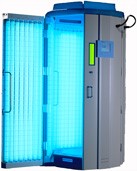Phototherapy in the Dermatology Clinic
What is phototherapy?
Phototherapy is a medical treatment. Ultraviolet light is used to treat some skin conditions, such as psoriasis, eczema, and vitiligo. It is also used for itching and other skin problems. It must be done under the care of a doctor and with a prescription.
How is it done?
You will undress and stand in a treatment light box. The box is lined with many light bulbs. The skin is exposed to ultraviolet B light. The dose and the number of treatments are based on the color of your skin and how you have responded to treatments if you have had them before.
- At first, you will be treated 2 to 3 times a week. As your skin gets better, this will slowly decrease to once a week.
- At first, treatments will last about one minute. The time will slowly increase. Some treatments last up to 10 minutes.
- You might only need treatment for a couple of months or you may need to do it year-round. To get the best results, you will need to follow the treatment plan. Missed treatments may mean the light dose will have to be reduced.
Important information
Skin products
- Put on unscented moisture lotions or creams before treatments. This will help the light get through the skin. Do not use skin medicines until after each treatment.
- Please tell the phototherapy staff about all medicines you take. Some medicines can cause the skin to be sensitive to light. Antibiotics, blood pressure, diabetes and cholesterol medicines are just some of these medicines. A lower light dose may be given to help prevent a burn.
- Use sunscreen with SPF 30 or higher when you are exposed to sunlight. This is very important on treatment days. Too much sun exposure on the days of treatments may cause dosing problems and sunburns.
Safety reminders
- Protective eye goggles must be worn during phototherapy. Keep your eyes closed as much as possible during treatments.
- Male patients must keep the groin area covered during treatments. Boxers, briefs, an athletic supporter, or a sock may be used to cover the area.
- No one in the booth should move during treatment without telling the nurse. Moving may cause a serious burn to areas that have yet not been exposed to the light.
- The booth is not locked. A treatment may be stopped at any time if needed.
What are some of the benefits of phototherapy?
- It can improve your skin problems and reduce flare-ups.
- Your skin condition may even seem like it has gone away. This is called remission. Each person’s response varies. Regular treatments may be needed to keep it under control.
- What are the possible side effects and risks?
- Tell the nurse about any side effects you are having before a treatment.
Side effects may be:
- Each person has a different reaction. Skin may be pink, red or tender. There may be some sunburn from time to time.
- Itchy or dry skin that is normally mild. Lotion may help soothe the skin.
- Rarely, a peeling type of sunburn and blisters may occur even with careful light doses.
Other risks include:
– An allergic reaction is very rare but can happen.
– Long-term UVB therapy can have a small risk of skin cancer.
– Eye damage if protective eye goggles are not worn.
– Aging of the skin, tanning and freckling.
– A reaction to a medicine you are taking called a photo-drug reaction. Be sure to tell us about all medicines, vitamins and over-the counter supplements you are taking.
– Sometimes it does not help a person’s skin condition.
– Other long-term effects that are not known at this time.
What kind of follow-up do I need?
You will need to see your skin doctor (dermatologist) every 2 to 3 months during phototherapy. Your doctor will look to see how your skin is responding to treatment and if you should continue. Phototherapy may not be done without the doctor’s continued orders.
Tell your doctor or nurse if any moles change in size, shape or color. Let them know about any new moles or pearly-looking bumps of the skin as well.
Does insurance pay for treatment?
Most insurance companies will cover phototherapy, but approval is needed before starting treatment. Our staff will check with your insurance company and then call you to set up a treatment schedule. Please allow 2 to 4 weeks for insurance approval. Phototherapy is subject to your deductible.



